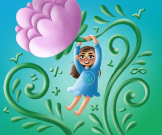Mathematical concepts are evolving, giving kids a reason to establish logical solutions. Geometry, a branch of mathematics, is an important part of the curriculum and helps children grasp the real physical world. If you want to give your child interactive geometry lessons, the Russian math framework can help. Under the guidance of a skilled tutor, Russian math geometry techniques can help develop problem-solving skills, abstract thinking, and self-reliance. The Russian Way of Teaching Geometry Russian math has an engaging way of teaching geometry. The approaches may be rigorous and rooted in the Soviet-era educational system, but they're still valid and helpful in strengthening visual-spatial reasoning skills. Kids learn to solve problems independently, discover new knowledge, and apply it to future challenges. We like to call it a BYOM (Build Your Own Math) activity, and here are some examples for better understanding: This Problem Is About Rotational Symmetry Say you are setting a round table with six identical plates. In how many ways can you arrange the setup so it remains symmetrical? With the BYOM method, kids are left to experiment and develop their own ideas. Some children might draw a circle on the paper and divide it like pizza slices. Others would test the arrangement with real cut-out shapes. Everyone then shares their solutions with the class - one kid might not be able to develop a new pattern, but another could find six possible symmetrical designs. The teacher helps kids observe the space between the plates, rotate the pattern, and understand what counts as a different arrangement. The idea here will be to introduce rotation and positioning, not just placement, to understand symmetry. Then, the teacher presents concepts like rotational symmetry and polygons in math so kids can connect their thoughts with this geometric vocabulary. The teacher would link it to real-world applications, like how artists use symmetry in their designs and how rotational symmetry is important in architecture. The ultimate discovery is how kids determine if a design is symmetrical, what patterns appear, and more. Here's Another Problem on Algebraic Expressions A packet contains apples and oranges, consecutively costing $2 and $4. Is there a way to write an expression and total the cost of n number of items in the pack? All the kids will have their ways, like writing full sentences or using symbols. The teacher gathers these ideas and introduces algebraic expressions to help kids understand how variables can simplify such calculations. This self-discovered knowledge remains with them for life. This One Focuses On Finding Area Kids need to find the total area of an L-shaped garden. According to Russian math geometry techniques, kids aren't told how things are done; they learn by doing it themselves. So, kids might rearrange the entire shape, cut it into rectangles, and share their methods with others in the class. The teacher then introduces the concept of decomposing complex shapes since there is no direct formula for finding the area of an L-shaped space. The teacher would suggest breaking the shape into two rectangles, finding the area of each, and adding them together, solving complex problems using simple logic. This helps kids develop foundational skills for real-world planning. They learn to question the why behind every concept and not just memorize formulas. Understanding Congruence Cut out two similar triangles. Rotate, flip, or slide them to see if they cover each other. If they do, they're congruent. Things to discuss: What makes the two shapes congruent? What are their lengths and angles? What keeps them unchanged? This allows kids to analyze complex information and develop constructive reasoning. Besides, understanding congruence is important in real life. If two shapes can be superimposed onto each other, like smartphones of the same series, pages of a book, and doors/windows of the same brand, they'll be congruent. With interactive geometry lessons, kids can create algorithms and formulas by themselves and understand concepts deeply. Try This to Understand Quadrilaterals Ask kids to draw a few different four-sided shapes like a kite, a computer screen, or a door. Have them identify all sides, vertices, angles, and intersecting diagonals. Question them, "What are the similarities and differences?" "Can you determine equal sides and angles?" "Which diagonals intersect and why?" and "Can you prove your solutions?" With such interactive geometry lessons, kids recognize patterns and establish logical explanations for these concepts. It encourages an investigative mindset so kids can observe and build an elementary math foundation as well as an understanding of advanced concepts. Such a Russian math framework prioritizes understanding over memorization. Russian math geometry techniques equip kids to develop proofs and identify uniqueness, buildability, and inequalities, applying these to real-world scenarios. Check out our videos to understand Russian teaching methods better. Need Help? Try Our Geometry Tutoring Online. At Russian Math Tutors (RMT), our teachers help kids of all levels excel in math. Kids can build a solid foundation with the right guidance and techniques. Our instructors encourage curiosity so kids can become thinkers and tackle even complex subjects. Our tutors love math and use their experience and background to introduce innovative teaching methods for deeper understanding. Click here to learn more.

| Private Lessons | | | Group Lessons |